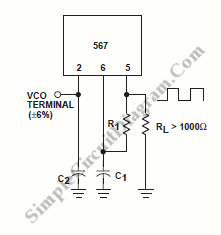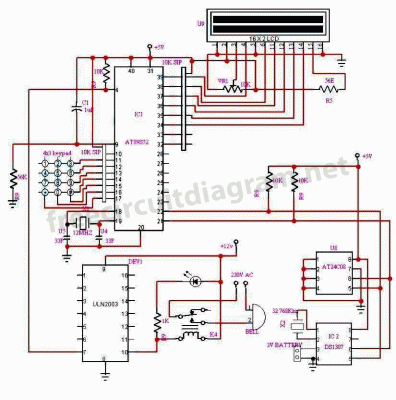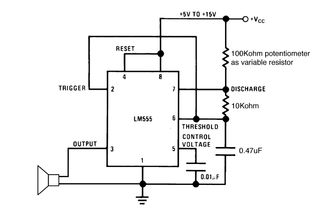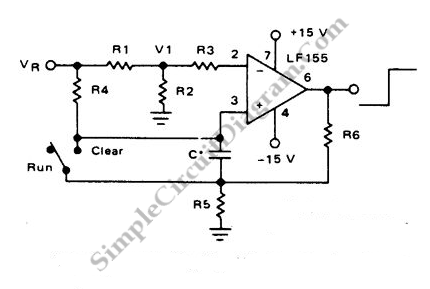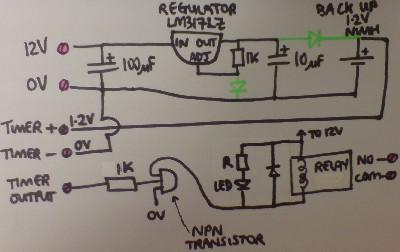
Precision time-countdown timer
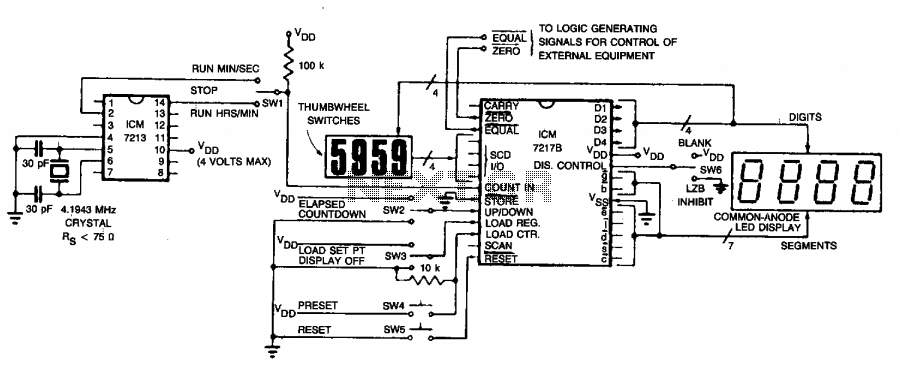
The circuit employs an ICM7213 precision timebase generator with a frequency of 4.1943 MHz, which is utilized for generating pulses that are counted by an ICM7217B counter. Thumbwheel switches are incorporated to allow the user to input a starting time into the counter for a preset countdown timer, as well as to configure the register for comparison functions. For example, to create a 24-hour clock with Binary-Coded Decimal (BCD) output, the register can be preset to 2400, and the EQUAL output can be used to reset the counter. It is important to note that a 10 kΩ resistor is connected between the LOAD COUNTER terminal and ground.
This resistor serves to pull the LOAD COUNTER input low when not in the loading state, which inhibits the BCD output drivers. If the BCD outputs are intended for use, this resistor should be removed, and switch SW4 should be replaced with a Single Pole Double Throw (SPDT) center-off switch.
The circuit's operation is contingent upon the precision of the ICM7213, which provides accurate timing through its crystal oscillator. The 4.1943 MHz crystal is crucial for maintaining the timing accuracy required for the countdown functionality. The ICM7217B counter is designed to count pulses generated by the ICM7213, allowing for precise time measurement and countdown capabilities.
The use of thumbwheel switches enables straightforward user interaction, allowing for easy input of desired countdown times. The ability to preset the register for comparison functions enhances the versatility of the circuit, making it suitable for applications such as digital clocks or timers.
In the context of a 24-hour clock, the register's preset value of 2400 corresponds to the maximum count for hours and minutes in BCD format. The EQUAL output provides a means to reset the counter once the preset time has elapsed, ensuring accurate timing.
Modifications to the circuit, such as removing the 10 kΩ resistor and replacing SW4, can be implemented to enable the use of BCD outputs. This allows for further integration with other digital systems or displays that accept BCD input, expanding the circuit's functionality and application range.The circuit uses an ICM7213 precision one minute/one second timebase generator using a 4.1943 MHz crystal for generating pulses counted by an ICM7217B. The thumbwheel switches allow a starting time to be entered into the counter for a preset-countdown type timer, and allow the register to be set for compare functions.
For instance, to make a 24-hour clock with BCD output the register can be preset with 2400 and the EQUAL output used to reset the counter. Note the 10 k resistor connected between the LOAD COUNTER terminal and ground. This resistor pulls the LOAD COUNTER input low when not loading, thereby inhibiting the BCD output drivers. This resistor should be eliminated and SW4 replaced with an SPDT center-off switch if the BCD outputs are to be used.
🔗 External reference
This resistor serves to pull the LOAD COUNTER input low when not in the loading state, which inhibits the BCD output drivers. If the BCD outputs are intended for use, this resistor should be removed, and switch SW4 should be replaced with a Single Pole Double Throw (SPDT) center-off switch.
The circuit's operation is contingent upon the precision of the ICM7213, which provides accurate timing through its crystal oscillator. The 4.1943 MHz crystal is crucial for maintaining the timing accuracy required for the countdown functionality. The ICM7217B counter is designed to count pulses generated by the ICM7213, allowing for precise time measurement and countdown capabilities.
The use of thumbwheel switches enables straightforward user interaction, allowing for easy input of desired countdown times. The ability to preset the register for comparison functions enhances the versatility of the circuit, making it suitable for applications such as digital clocks or timers.
In the context of a 24-hour clock, the register's preset value of 2400 corresponds to the maximum count for hours and minutes in BCD format. The EQUAL output provides a means to reset the counter once the preset time has elapsed, ensuring accurate timing.
Modifications to the circuit, such as removing the 10 kΩ resistor and replacing SW4, can be implemented to enable the use of BCD outputs. This allows for further integration with other digital systems or displays that accept BCD input, expanding the circuit's functionality and application range.The circuit uses an ICM7213 precision one minute/one second timebase generator using a 4.1943 MHz crystal for generating pulses counted by an ICM7217B. The thumbwheel switches allow a starting time to be entered into the counter for a preset-countdown type timer, and allow the register to be set for compare functions.
For instance, to make a 24-hour clock with BCD output the register can be preset with 2400 and the EQUAL output used to reset the counter. Note the 10 k resistor connected between the LOAD COUNTER terminal and ground. This resistor pulls the LOAD COUNTER input low when not loading, thereby inhibiting the BCD output drivers. This resistor should be eliminated and SW4 replaced with an SPDT center-off switch if the BCD outputs are to be used.
🔗 External reference
Warning: include(partials/cookie-banner.php): Failed to open stream: Permission denied in /var/www/html/nextgr/view-circuit.php on line 713
Warning: include(): Failed opening 'partials/cookie-banner.php' for inclusion (include_path='.:/usr/share/php') in /var/www/html/nextgr/view-circuit.php on line 713
